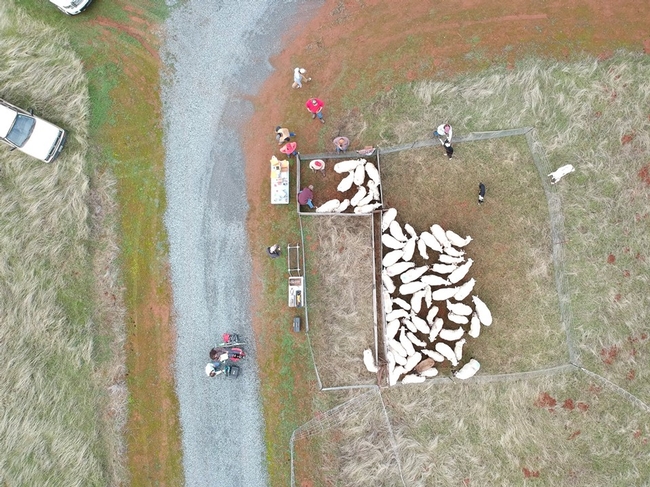Bud Williams, in many respects, was the leading expert on livestock handling and stockmanship on the planet. I never had the opportunity to meet Bud personally, but I have learned from several people who learned directly from him - notably Roger Ingram (my predecessor as livestock advisor) and from Steve Cote, who teaches and writes about Bud's techniques today.
Roger had the opportunity to work directly with Bud at a cattle feedlot in Canada in 1993, an experience he writes about in Belief and the Will To Do It. Low-stress stockmanship, Roger writes, requires a change in attitude:
Old Attitude: "I'm going to MAKE that animal do what I want."
New Attitude: "I'm going to LET that animal do what I want."
Old Attitude: "That miserable [fill in your own profanity] cow [or sheep, goat, etc.] broke back [missed the gate, charged me, got sick, etc.].
New Attitude: "What did I do to cause the animal to react that way?"
Steve Cote, in his first book, Stockmanship: A Powerful Tool for Grazing Lands Management, writes:
"The best handlers have the best attitudes. They watch, adjust, and constantly move to where the stock show them the need to be to get the job done right, all the time."
As I've worked my own sheep, and helped other producers handle cattle, sheep and goats, I've realized that low stress stockmanship is a continual learning process. The key, for me, is that I believe in it - I've seen the results when it works well! When something doesn't work, though, I don't abandon my belief in the approach; rather, I think about what I could have done differently. Thoughtful stockmanship requires us to assume that if the animals aren't doing what we expect or desire that they are trying to communicate with us (rather than misbehaving).
This idea that stockmanship is a lifelong learning process, at least for me, is what separates Bud Williams from Temple Grandin. Dr. Grandin's facility designs are excellent, but in many ways they are designed to minimize stress on livestock when the handlers using the system are not students of stockmanship. Bud Williams' designs, on the other hand, work amazingly well because they are based on the principle that the handlers understand livestock behavior. The "Bud Box," which we use in our sheep corrals, is a great example of this principle.
Bud taught that animals will follow certain instinctive behaviors if they are in a normal mental state. Animals want to move in the direction they are headed; they also instinctively prefer to exit a pen where they entered it. They want to follow other animals (in other words, movement creates more movement when working with a herd or flock). They want to see what is pressuring them. If we want them to speed up, we can walk in the opposite direction of their movement; walking in the same direction as the animals will slow them down.
The Bud Box system takes advantage of these behaviors. Unlike the solid-sided, curved alleys and sorting "tubs" typical of many of the Dr. Grandin-designed facilities I've seen, the Bud Box is simple, open-sided, and straight. The Bud Box itself is a smallish pen at the head of the alley (for our sheep corrals, this pen is 8 feet by 10 feet - big enough for 8-10 ewes). The direction of movement into the alley is back towards the location where the animals entered the corrals (so they naturally want to return there). The opening at the head of the alley allows the animals to move away from the pressure of the handler working in the Bud Box - this handler simply walks from the opening diagonally through the Bud Box, which induces the animals to move away (and into the alley) in a calm manner. From there, a handler can walk with purpose in the opposite direction of the animal flow through the alley - this will induce the animals to move up the alley (towards a squeeze chute, or in our case, towards our sort gate). All of this can be done WITHOUT yelling, whistling, or using hot shots (or even rattle-paddles) to force the animals to go where we want them to go.
In our sheep operation, I've found that I can sort a group of sheep quickly working with just a dog. The dog helps load the Bud Box. The sheep are trained to the system - they will usually put themselves in the alley. While I stand at the sort gate at the end of the alley, the dog walks in the opposite direction of the sheep in the alley, which causes them to move forward (and through my sort gate).
Last month, we held a workshop on trimming feet and giving vaccinations to sheep. Using a drone, Roger was able to provide a bird's eye view of the Bud Box. This YouTube video shows us loading the alley, scanning ear tags, and sorting a wether into a holding pen.
Working animals rarely goes perfectly! Problems, at least when I'm in the proper frame of mind, are learning opportunities. Stockmanship requires cross-species communication (indeed, in the video above, there are sheep, dogs, and humans trying to communicate with one another). In my experience, time for reflection is also important - thinking about what worked (and what didn't) can make us better stock handlers!
